FROM THE PERIMETER OF SQUARE FROM THE LENGTH OF DIAGONAL
Problem 1 :
Find the side length of the square.
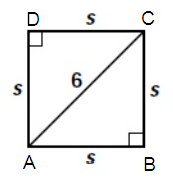
Solution :
AB = s, AC = 6, BC = s
Using Pythagorean theorem.
(AC)2 = (AB)2 + (BC)2
62 = s2 + s2
36 = 2s2
Dividing 2 on each sides.
36/2 = s2
18 = s2
s = √18
s = √(9 × 2)
s = 3√2
So, the sides of a square is 3√2.
Problem 2 :
The perimeter of a square is 400 m. calculate the length of the diagonal of the square.
Solution :
Let x be the length of the diagonal of the square.
The perimeter of a square is 400 m.
Perimeter of a square = 4 × side
400 = 4 × side
Side = 400/4 = 100
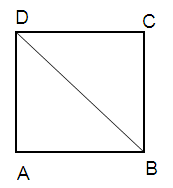
AB = 100, AD = 100, BD = x
Using Pythagorean theorem.
(BD)2 = (AB)2 + (AD)2
x2 = (100)2 + (100)2
x2 = 10000 + 10000
x2 = 20000
x = √20000
x = √(100 × 100 × 2)
=
100√2
So, the length of the diagonal of the square is 100√2.
Problem 3 :
The perimeter of a square is 36 m. calculate the length of the diagonal of the square.
Solution :
Let x be the length of the diagonal of the square.
The perimeter of a square is 36 m.
Perimeter of a square = 4 × side
36 = 4 × side
Side = 36/4 = 9

AB = 9, AD = 9, BD = x
Using Pythagorean theorem.
(BD)2 = (AB)2 + (AD)2
x2 = 92 + 92
x2 = 81 + 81
x2 = 162
x = √162
x = √(81 × 2)
x = √(9 × 9 × 2)
x = 9√2
So, the length of the diagonal of the square is 9√2.
Use the information marked on the figure to find the value of x.
Problem 4 :
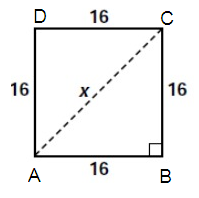
Solution :
AB = 16, BC = 16, AC = x
Using Pythagorean theorem.
(AC)2 = (AB)2 + (BC)2
x2 = (16)2 + (16)2
x2 = 256 + 256
x2 = 512
x = √512
x = √(256 × 2)
x = 16√2
So, the value of x is 16√2.
Find the perimeter of quadrilateral WXYZ.
Problem 5 :
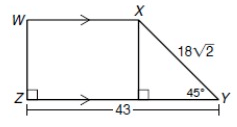
Solution ;
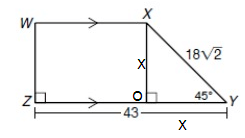
OY = x, OX = x, XY = 18√2
Using Pythagorean theorem.
(XY)2 = (OX)2 + (OY)2
(18√2)2 = x2 + x2
2x2 = 324 × 2
2x2 = 648
Dividing 2 on each sides.
2/2x2 = 648/2
x2 = 324
x = √(81 × 4)
x = 18
ZY = ZO + OY
43 = ZO + 18
ZO = 43 – 18
ZO = 25
OY = 18, OX = 18, XY = 18√2
WX = 25, ZO = 25, WZ = 18
So, the perimeter of quadrilateral WXYZ is,
WX + WZ + ZO + OX + XY = 25 + 18 + 25 + 18 + 18√2
= 86 + 18√2
Problem 6 :
If the perimeter of a square is 8, which is the length of the diagonal ?
A) 2√2 B) 2√3 C) 8√2 D) 4
Solution :
Let x be the length of the diagonal of the square.
The perimeter of a square is 8.
Perimeter of a square = 4 × side
8 = 4 × side
Side = 8/4 = 2

AB = 2, AD = 2, BD = x
Using Pythagorean theorem.
(BD)2 = (AB)2 + (AD)2
x2 = 22 + 22
x2 = 4 + 4
x2 = 8
x = √8
x = √(4 × 2)
x = 2√2
So, the length of the diagonal is 2√2.
Hence, option A) is correct.
Recent Articles
-
Finding Range of Values Inequality Problems
May 21, 24 08:51 PM
Finding Range of Values Inequality Problems -
Solving Two Step Inequality Word Problems
May 21, 24 08:51 AM
Solving Two Step Inequality Word Problems -
Exponential Function Context and Data Modeling
May 20, 24 10:45 PM
Exponential Function Context and Data Modeling